This story is the real thing. If we wanted to make up the nightmare and danger to which they are exposed at 2,700 meters from the sea, I believe that we would not be able to achieve so many details. This story is by no means a fairy tale; the experiences of the men who inspire these lines have made us ask for justice.
It looked like a TV show
What we were about to observe with our own eyes looked like we would only see it through television screens.
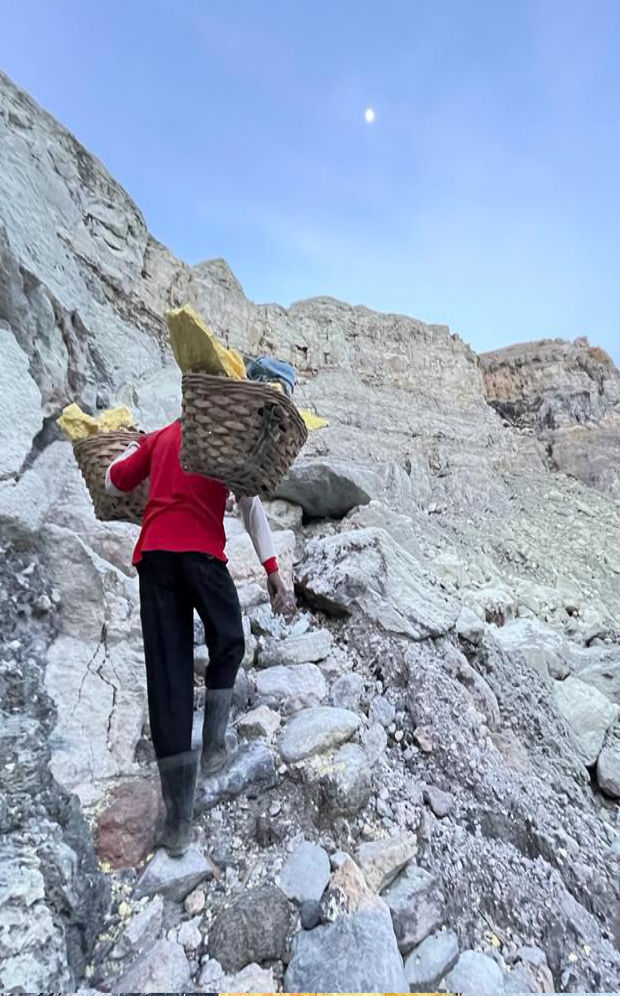
Early that Friday morning, at the base of the IJEN volcano, 2,700 meters above sea level, we met Alby Alfarizi.
Alfarizi is a miner like many others in the area, not very corpulent, with sturdy and strong humanity, slim in body and even more so in the face, short in stature, dark, and above all with an always affable attitude.
A man who with his wide smile, the transparency of his eyes, and basic English that he can only practice when tourists visit the area, served as our guide in this place full of contrasts.
It was 3 a.m. when Alby offered us a cup of kopi luwak.
Kopi means coffee in Indonesian, and the luwak a groundhog-like animal that eats ripe coffee beans, when this animal defecates, the coffee is harvested and processed, it is considered one of the most expensive and unique coffees in the world, produced in a nearby village.
With the cup of coffee in our hands, the minutes passed and the cold ran through our bodies, so we tried to ease the low temperatures with some logs that despite the smoke helped us to warm up.
At that time of the morning, the only way to get to the IJEN volcano was by private transport, so we hired the service before midnight to pick us up from Bondowoso, a coffee village not far from the volcanic area where we were headed.
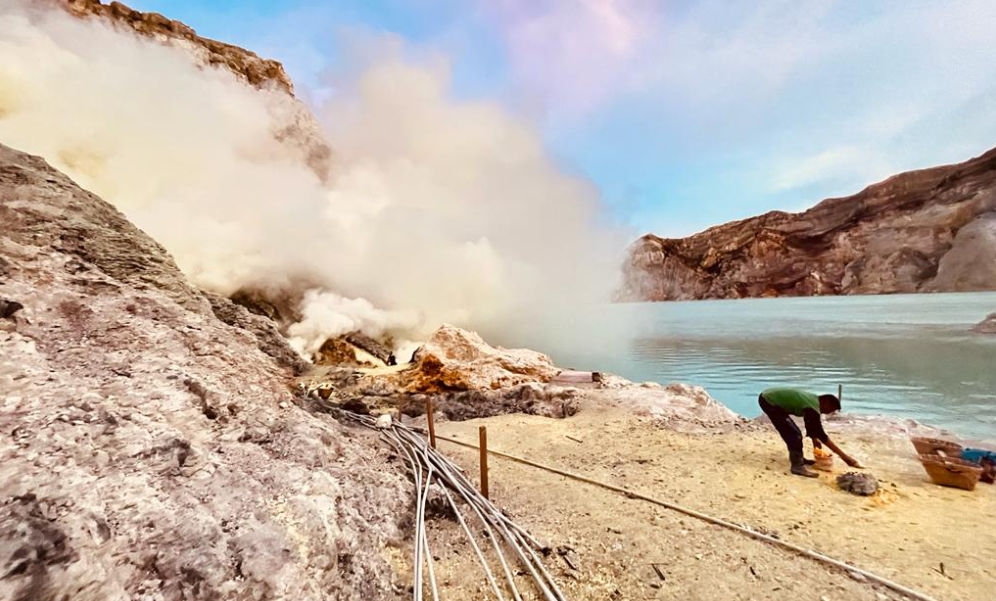
The south of the island of Java in faraway Indonesia has a very particular geography. It is a mountainous area, full of coffee plantations and roads with steep curves, sparsely populated in terms of urban centers so public transport is still very limited.
After taking the Kopi luwak we headed to the entrance of the KAWAH IJEN GEOLOGICAL PARK, we paid 8 dollars for the entrance ticket and picked up some gas masks, which, according to our guide, would be necessary for when we were at the base of the crater.
It is at that moment that our adventure to the crater of the KAWAH IJEN volcano, one of the more than 130 active volcanoes in Indonesia that belong to the Pacific Ring of Fire, begins.
A few days ago, some locals who live on the slopes of the Bromo volcano, recommended us to visit this area so we were eager to know and see a natural phenomenon that in Indonesia is only seen in the KAWAH IEJN.
This effect is called The Blue Fire, which is created when the fire that comes from deep in the earth by the presence of sulfur dioxide gases associated with volcanic activity takes an intense blue hue.
Climbing the volcano
So here we were, with more desire than energy ready to continue the adventure. The road was difficult from the beginning. It was only 100 meters flat before we encountered a wet and slippery dirt road that sloped uphill at angles that were probably as steep as 45 degrees.
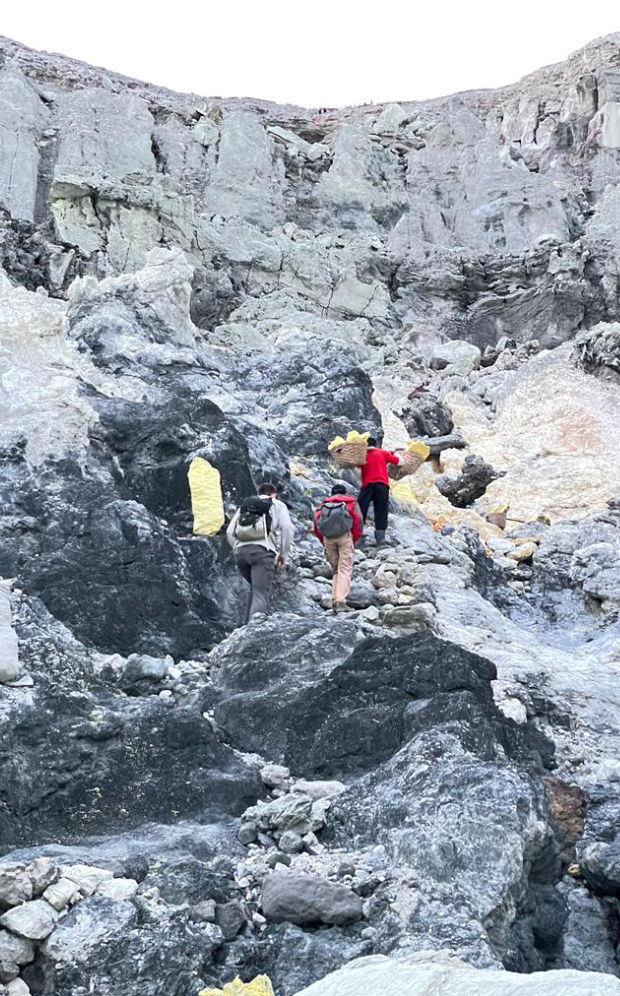
However, perhaps because of our heavy breathing or the fatigue that was beginning to show, Alby reassured us that in a couple of kilometers we would be on a long plain before reaching the crater ring of the volcano.
It was there, during that long walk uphill, where he told us a little of his life as a miner and guide, of Diana, his wife, and Alfarizi, his son; it was that talk and what we experienced that day in the crater that inspired us to write these lines.
Half an hour had passed since the beginning of our hike to the crater of the volcano when in the middle of the ascent we noticed something that more than curiosity generated in us an open discomfort.
Alby’s fellow miners, small like him, using a kind of cab, which more than a cab was a stretcher with wheels, offered to carry tourists big or small uphill the 3.5 kilometers that separated us from the entrance to the crater ring.
In the best English colonial style, three guides would pull with all their might any tourist willing to pay the 800,000 rupees that the service cost, something like USD$60.
This amount of money was to be divided equally among the three brave porters. We thought it was a nonsense for someone in full use of his physical capacities to pay for this Belgian-style service in the Congo.
However, we later understood why these kind guides were fighting to carry heavy tourists with the promise of receiving about USD$20 each after their titanic task. It seemed little yes, but we later learned that it was the best option for them.
Alby kept his word, and after less than two kilometers uphill, we reached the plain that announced the proximity to the crater ring. According to our friendly guide, from there the “easy” part of the trail would end and we would begin the descent of about 45 minutes down the steep rocky walls of the volcano until we reached the turquoise blue lake at the bottom, right next to the volcano’s calderas.
Despite the distance, the darkness and the cold of the night, we could see the volcano’s fumaroles in the distance, loaded with the sulfur that would give us our much desired natural spectacle. With us there were about 50 tourists who, eager to see the phenomenon, were going down the same rocky rocks as us, helped only by the flashlights in their heads.
Finally, around 4:30 a.m., we received the order from our guide that we were waiting for, announcing the imminent end of our hike. “Please wear your gas masks, from this moment on, the gases are harmful to your lungs, do not take them off at any time unless we are away from the fumaroles”, the same fumaroles that were coming out of the center of the earth.
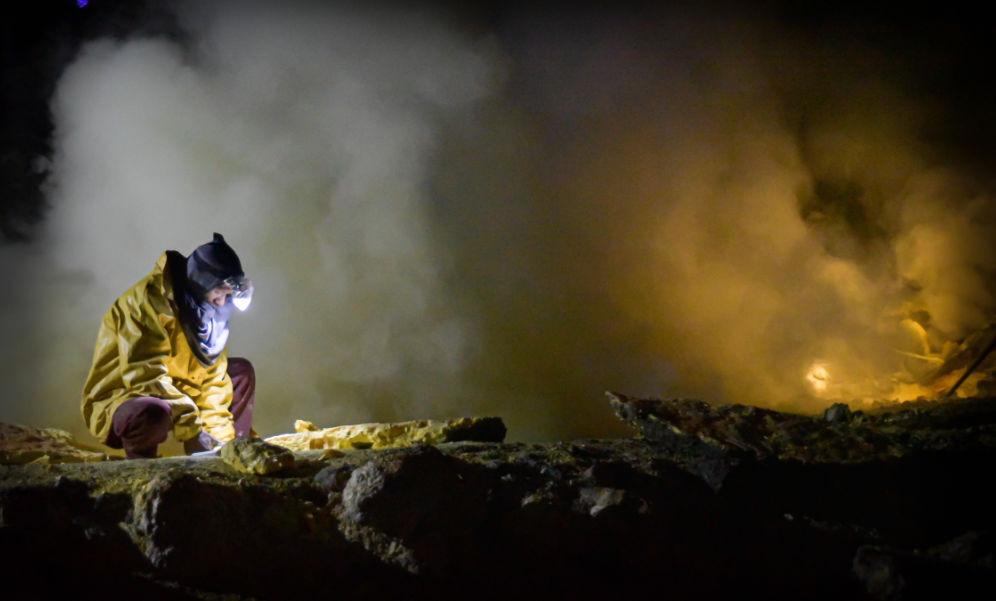
Along with his instructions came a piece of advice that was very useful during the next few hours in the crater “If you see smoke surrounding you, don’t despair, just kneel down, keep low, close your eyes and wait for the smoke to dissipate”. The truth is that we did not expect it to be so serious, or that we would need this advice, so we just listened to her with some disbelief and walked the last 20 meters to where the blue fire could be seen more clearly.
In all fairness to us and to the reader who has come this far, we must say that, if the blue fire was present, it was clearly visible, it was still a curiosity and although it was an impressive phenomenon, it was very little, it was small and was constantly covered by the fumes of the volcano.
In order to observe the phenomenon or have a decent photo it was necessary to share the scene with 50 other people who wanted the same thing, so after the initial excitement of the first 5 minutes, and with some disappointment, but definitely grateful to be there, we just watched the phenomenon from afar and explore the surrounding area, at the end of the day we were in the crater of a volcano and that was no small thing.
The miners of hell
It was there, at the bottom of the crater exploring the area a bit, that we noticed with disbelief something that seemed to be invisible to the eyes and cameras of the other tourists.
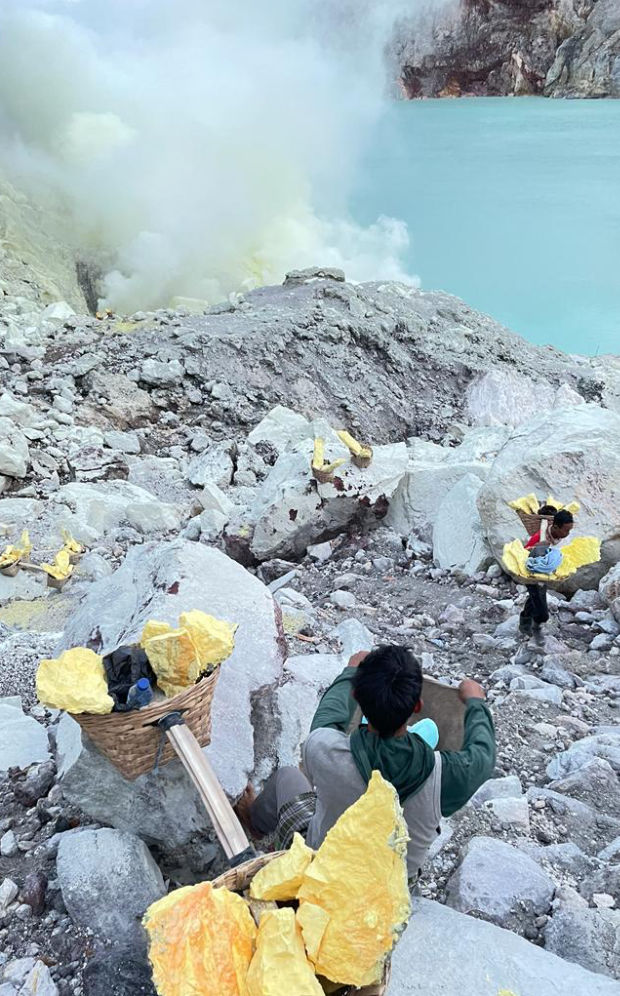
Dozens of Indonesians, all small men like Alby and friends of his, were working from the early hours of the morning right next to where those clouds of sulfurous gases so harmful to health and at very high temperatures were coming out, in sulfur mining or as the locals call it the “devil’s gold“.
This group of men mingled with the hordes of tourists that had arrived there, being almost invisible to many and, with metal rods of about 2 meters, they approached the fumaroles of the volcano where the sulfur gas condensed into a blood red liquid that after cooling and hardening would become sulfur ore, to break it into small light yellow stones.
These stones had to be collected and broken into smaller parts for transport amidst clouds of toxic gas with almost no industrial protection for feet or hands, and only a light respirator more appropriate for the paint industry than for the mining industry.
paint industry than for open-pit mining.
We moved a little away from the fire, and about 30 meters away there were other cracks in the volcano from where the sulfurous fumes emanated profusely, which these brave miners turned into rocks with which they in turn filled their handmade wicker baskets of between 50 and 90 kilograms. It was at that moment when we set out to portray with images the work that we thought would be the most difficult, dangerous and poorly paid job in the world.
Even at night, around 5:30 in the morning, we approached a miner who was breaking with a small axe a rock of about 150 kilograms, and it was just when a cloud of sulfur dioxide gas enveloped us completely.
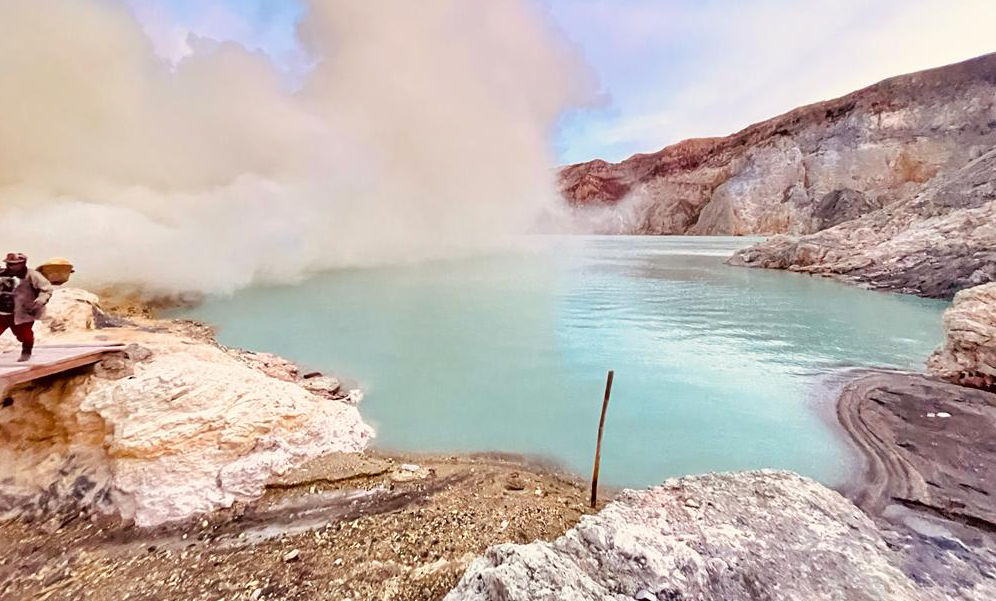
Remembering Alby’s recommendations we crouched down and closed our eyes waiting for the gas to pass and we could continue recording this strange place in pictures, but the cloud remained.
Our eyes began to burn, even with them closed, and a lump in our throat made it difficult to breathe, after a few seconds the sensation gave way to an open desire to vomit and clear despair.
Just when despair was taking over our minds because of the toxic atmosphere and the impossibility of taking action, the cloud dissipated and gave way again to a clear and diaphanous sky, where the miners were still working as if none of this had even happened.
The mineral is the only thing that matters
The gas clouds came and went without knowing when, it was all a matter of the volcano’s will. Sometimes, as we approached them, we could listen in disbelief to the sounds they made when these clouds enveloped them. It was a strange mixture of moaning, discomfort and desire to vomit that came out of their hurt throats, however, after a few seconds they would go back into the bowels of the volcano’s fumaroles and continue their mining work without any other choice.
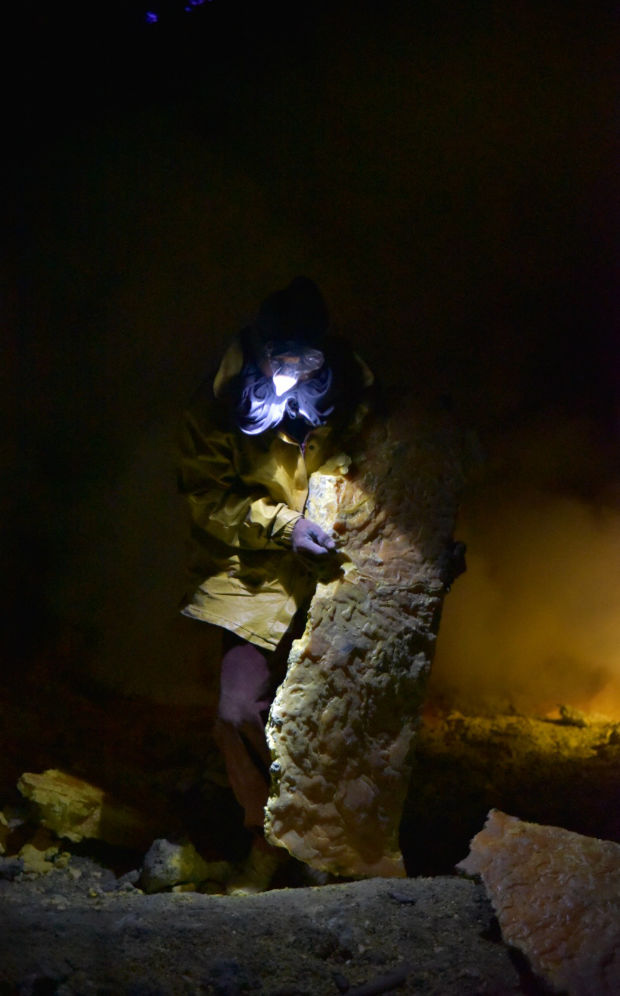
At a moment just before dawn, still cold and under a clear sky, a miner approached us, extended his hand and offered us for sale a piece of sulfur recently stolen from the bowels of the volcano, his head flashlight illuminated us and did not let us see his face, there was a lot of smoke because of the proximity to a crack of the volcano and it was dark; he did not speak, just extended in his hand a piece of “devil’s gold”.
It was there, where, after our refusal to purchase his product, we realized that this situation was nothing more than an analogy of the life of almost all these brave and forgotten miners who inspire these lines these lines. We never knew who was behind that piece of sulfur, we did not have time, he left and was lost among the fumaroles of the volcano, we were only left with the image of sulfur.
The mineral is the only thing that matters in these lands, the mineral that the company that owns the license buys in conditions of human indignity for the whitening of sugar, for the elaboration of beauty creams or for the production of matches, but it is only that “the mineral” that matters, not the human face, nor the humanity that owns the hands of who stole this from mother earth in the bowels of a volcano on an island in faraway Indonesia.
We stayed until after 9 am in the area, the night gave way to a sunny and clear morning that let us see all the beauty of the place where we received the sun that day. It was definitely a beautiful and unique place with a lake of an intense turquoise blue that is nothing more than a lake of sulfuric acid and hydrochloric acid at 40 degrees Celsius, a product of volcanic activity, and that was shown in all its splendor while the miners were still there with their promising work.
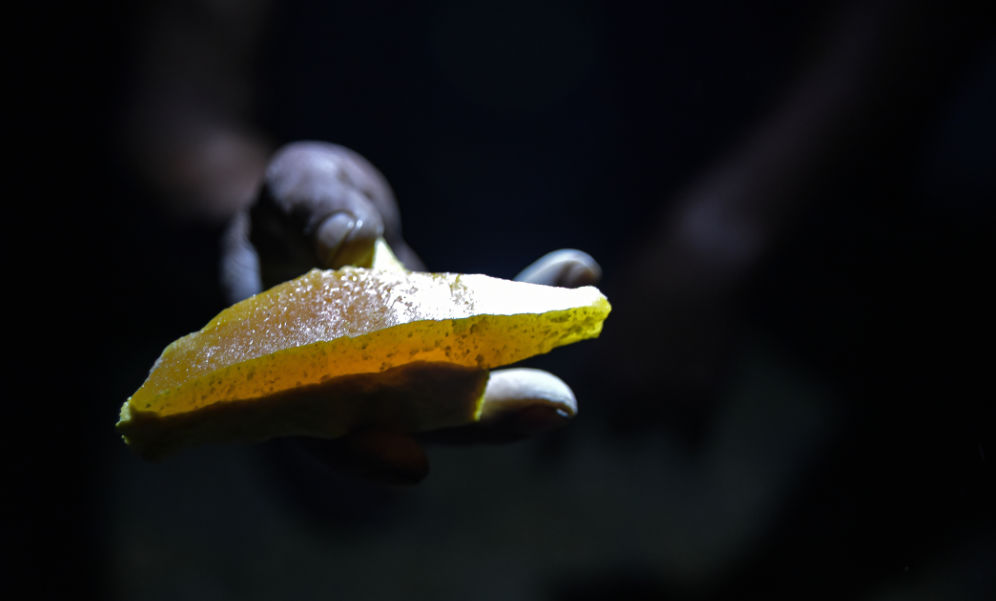
The tourists had already left the area with the first light of day and there were only these men working as if nothing had happened, in the repetition of their eternal present and without the slightest hope that something will change for them or their families, dedicated to the mining of “devil’s gold”, so, with the calm of those who are not in a hurry, we had the opportunity to talk to some of them.
These men told us that they start their journey around 1:00 a.m. and walk the entire 4 kilometers we did to the crater, once there with no more protection than that simple paint mask, some of them even in sandals, undertake the task of stealing a few kilos of the nearly six tons of sulfur ore that the volcano can naturally produce in a day, and then climb on their shoulders uphill, once or twice a day, with their precious load of “devil’s gold” of up to 90 kilograms, and thus be able to sell the kilo at 1. 250 rupees, about 6 cents.
The sad conclusion
In other words, these miners in the 21st century expose their lives, their health and integrity, and work long hours, without any protection from fumes or burns and in undignified working conditions that humanity should have already overcome.
These condemned men are the ones who transport a load of sulfur for the company that sometimes exceeds their own weight and earn less than 8 dollars a day, all this before the eyes and complicity of hundreds of people who do not see or do not want to see, in this practice, something despicable, reprehensible, because they only visit the volcano with the sole intention of taking a picture for the memory. This is how frivolous and unfair is the reality that is lived in these distant lands.

As we said at the beginning of this chronicle, it is for this reason that the miners prefer to carry heavy tourists 3.5 kilometers uphill, because in this way, at least, they do not risk their lives in the maw of the volcano and, as difficult as it may be, it is easier than the work they do every day.
Finally, we walked the nearly 4 kilometers back to the base of the volcano, talking with Alby about his dreams, his fears, his inability to leave this job, his life in general, his plans to have another child, and how what he earns is barely enough to pay for the 15,000 rupees of gasoline to get to the volcano.
The money he has left over he gives to his wife Diana, with which she feeds the family, pays the school fees for little Alfaziri, and has some left over for the used motorcycle. The “salary” Alby earns is not bad, in fact, it is above average in INDONESIA.
However, under these working conditions, and in the face of the company’s reluctance to protect its miners, it is certain that neither Alby, nor the hundreds of miners who work there, will have an old age to enjoy for their children and grandchildren.
Meanwhile, tourists will continue to arrive in search of a photo, and the company will continue to make money with impunity at the expense of the safety of men condemned to sell not only their labor, but their health, their dreams and their dignity in order to live.


